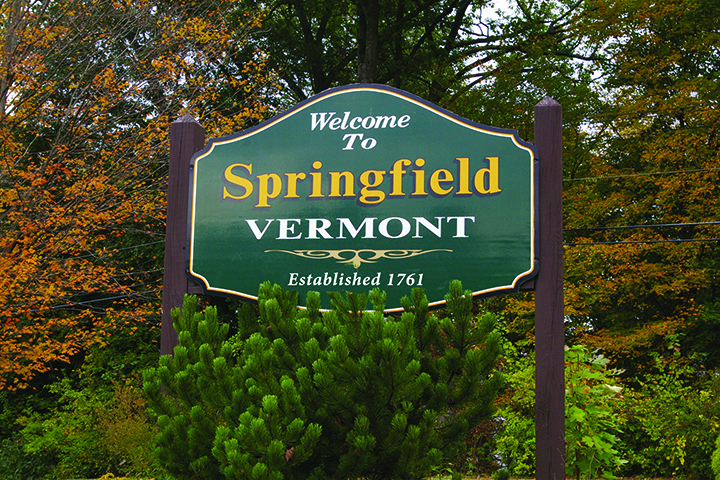
SPRINGFIELD, Vt. – Israel Maynard from Stantec engineering consultants attended the Monday, Sept. 23, Springfield Selectboard meeting, to revisit the Northern Gateway Scoping Project and review the parking plans for each of the alternatives. The board had previously considered three proposals to develop a pedestrian-bicycle path and greenway connecting the downtown area to the shops along River Street, but wanted to further clarify the parking options.
Town manager Jeff Mobus noted that, “There is no future commitment tied to this scoping project,” and there were “multiple [infrastructure] projects” that would need to be completed before the gateway project could be considered. The board needed to choose an alternative to complete the scoping study and begin the grant application process.
Maynard explained that the challenge with parking in the area currently is that vehicles must back out across the sidewalk into the roadway to exit a parking space, which results in an unsafe situation. Maynard ran through the alternatives for parking with the board. Alternative 1 would create around 47 perpendicular parking spaces adjacent to the roadway. The parking plan for Alternative 2 and 3 would improve safety by managing access with a 1-way aisle with 40 angled parking spaces. Alternative 4 would leave the parking informal, but with managed access and two entry/exit points.
The property is privately owned, and Mobus expressed that the owner is not on board with making changes to the lot because there is not enough parking for tenants as it is. Alternatives 1-3 would each require an easement from that owner, while alternative 4 requires no easement, as it makes no change to the parking set up.
Vice Chair Michael Martin asked Mobus if the town might negotiate with the owner, since the improvements to safety and aesthetics would be mutually beneficial. Mobus said he didn’t think they would agree to any alternative that would reduce the number of parking spaces. Martin remarked that Alternative 3 would come closest to achieving the goals originally set in the Main Street Master Plan, and provide a gateway to downtown.
Maynard added that negotiating with the owner “would need to be a bit of a swap. You’re giving up part of the right-of-way so that they can park in it, and they give up part of their property for the shared use path.”
The board chose Alternative 3, with Alternative 1 as a backup in the event the owner was unwilling to lose parking spots.
The board heard objections to their recent call for a ban on firearms discharge in Hartness Park from resident Ramona Emery and other citizens, who have been circulating a petition to repeal the new ordinance.
Chair Kristi Morris told the petitioners they would need at least 320 verified signatures for the petition to be accepted, and as of Wednesday, Sept. 25, the residents had collected the required number of signatures. The board then scheduled a special meeting for Tuesday, Oct. 1, where they will set the date of the townwide vote on the ordinance, as well as the date and time of the informational hearing to precede the vote.
The board heard from Frank Knaack from the Housing and Homelessness Alliance of Vermont (HHAV), who presented them with an overarching housing report that can be viewed within the meeting packet on the town website. The report includes data on unhoused people, people in government-assisted housing programs, individuals covered under Social Security (SSI) and disability (SSDI) benefits, potential housing solutions, and more. The study was conducted in accordance with Act 113, which allows for the use of hotel and motel rooms as emergency housing for vulnerable households who meet the eligibility requirement. Recent changes to Act 113 have lowered the cap on the number of rooms made available for the program, which presents new challenges.
Knaack admitted that now the picture is somewhat “dark,” with resources at capacity, but said he was encouraged by recent investments by the state in affordable housing solutions. Knaack remarked, “We’re seeing progress, but it’s taking time.”
Mobus reported that he has participated in a statewide initiative “driven by town officials to discuss the homelessness challenge. I believe that Springfield will begin seeing growth in the unhoused population and an increased demand in our services,” Mobus stated in his manager’s report. “There aren’t any easy solutions, but this conversation needs to continue.”
In his public safety update, Springfield Police Chief Jeff Burnham reported that the department had onboarded a “full-time recovery coach.” Jen Pierson, an employee of Turning Points Recovery Center, started working with the department last month.
“With Jen working with substance misuse issues and Donna Burns working with issues involving mental health, the police department is better equipped to address the calls for service that don’t actually need a police response,” stated Burnham.
Burnham also commented that the department’s intent was not to become “the homeless police,” and told Knaack he would appreciate any advice he might share down the road.
The next regular board meeting will be held Monday, Oct. 14, at 6 p.m.